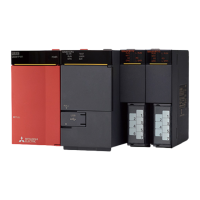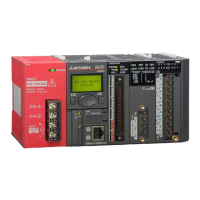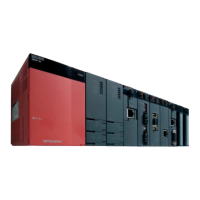7 APPLICATION INSTRUCTION
7.20 Timing check instruction
603
7
Hour meter
HOURM
This instruction measures the on time of the input contact in units of hour.
■Descriptions, ranges, and data types
■Applicable devices
• This instruction measures the period of time for which the input contact is on in units of hour, and turns on the device
specified by (d2) when the accumulated ON time exceeds the time (16-bit binary data) specified in (s).
• In (s), specify the period of time until the device specified by (d2) is turned on in units of hour.
• The measured current value in units of hour is stored in (d1).
• The measured current value of less than one hour (in units of second) is stored in (d1)+1.
• (d2) is set to on when the current value in (d1) exceeds the time specified by (s).
• Specify a latched (battery backed) type data register as (d1) so that the current value data can be continuously used even
after the power to CPU module turns off. If a general data type register is used, the current value data is cleared when the
power to the CPU module is turned OFF or when the controller mode switches from STOP to RUN.
• Even after the alarm output specified by (d2) turns ON, the measurement is continued.
• When the current value reaches the maximum value of 16-bit data, the measurement is stopped. For continuing the
measurement, clear the current value stored in (d1) to (d1)+1.
• Two devices are occupied by (d1). Make sure that these devices are not used by other machine controls.
Ladder diagram Structured text
ENO:=HOURM(EN,s,d1,d2);
Operand Description Range Data type Data type (label)
(s) Time after which the alarm (d2) is set to on (unit: hour) 16-bit signed binary ANY16
(d1) Device for storing the measured current value (latched (battery
backed) type data register)
16-bit signed binary ANY16
(d2) Device to be turned on when timeout occurs (alarm output) Bit Bit
Operand Bit Word Double word Indirect
specification
Constant Others
X, Y, M, L,
SM, F, B, SB
U\G T, ST,
C, LC
T, ST, C, D,
W, SD, SW, R
U\G Z LC LZ K, H E $
(s)
(d1)
(d2)
Error code
(SD0/SD8067)
Description
2820 The device areas specified by (d1) exceed the corresponding device range.
3405 The value of (s) is negative.

